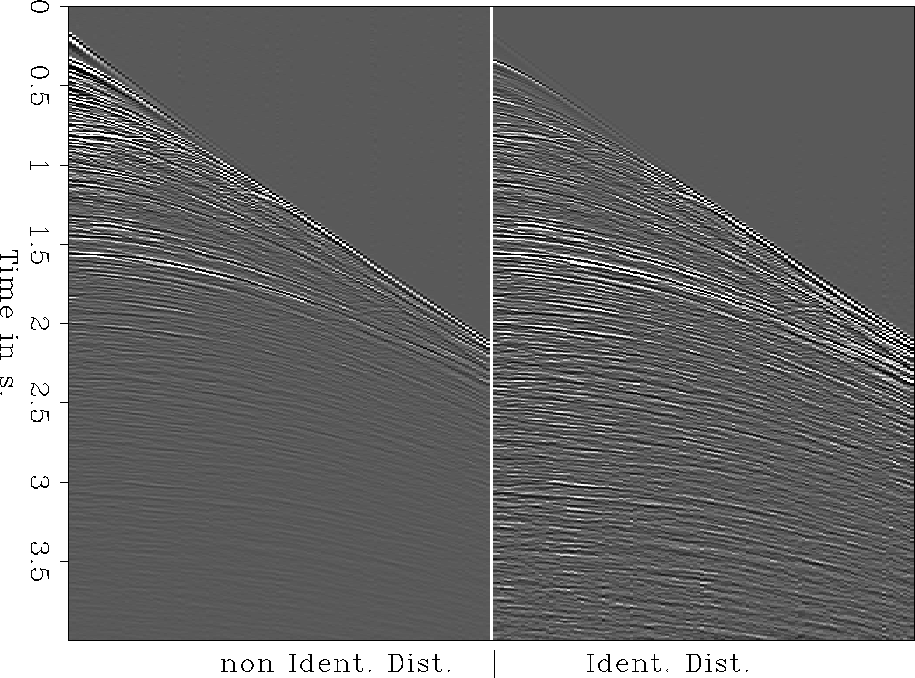




Next: What will I do?
Up: Guitton: Coherent noise attenuation
Previous: Guitton: Coherent noise attenuation
Preserving the amplitudes requires inverse theory when an operator is not unitary.
Unfortunately, seismic operators are usually not unitary.
Seismic operators can be regarded as the adjoint of forward ``modeling'' operators
Claerbout (1992). Lailly (1983) was the first to recognize that the standard
migration operator is the adjoint to the corresponding forward operator and used
it in the first iteration of full waveform inversion Tarantola (1987). Because
the adjoint is not the inverse of the operator, the amplitude of the
input data is not preserved. An approximate inverse can be computed using
least-squares inversion. Thorson (1984) replaces the standard hyperbolic
Radon transform with a linear, least-squares inversion of the velocity stack equations.
However, the least-squares operator involves the computing of the inverse of the
Hessian that is often very difficult to derive.
Forgues and Lambare (1997) and Chavent and Plessix (1999) calculated an approximate
inverse of the Hessian matrix associated with the migration operator.
When the calculation of the least-squares inverse is not feasible
(size of the matrices, use of operators instead of matrices), an iterative scheme is preferred.
However, with a least-squares inversion, major difficulties arise when the data
are contaminated by noisy events. By noisy event I mean
- Abnormally large or small data components, or outliers, where
long-tailed probability density functions (pdf) should be used as opposed
to short-tailed Gaussian pdf.
- Coherent noise that the seismic operator is unable to model
(for example, a hyperbolic Radon transform can't properly model ellipses).
The noise will (1) spoil any analysis based on the result of the inversion
and (2) affect the amplitude recovery of the input data. From a more statistical
point of view, the residual, which measures the quality of the data fitting, will
be corrupted by high amplitude (outliers in the data) or highly correlated
events (coherent noise in the data) that will attract much of the solver's
efforts, thus degrading the model m. The first I in IID stands for
Independent, meaning that no coherent events are present in the residual (hyperbolas, ellipses,
lines, etc.). The second I and D stand for Identically Distributed, meaning that the residual
components have similar energy. For example, if seismic data have not been multiplied
by t2 to correct for spherical divergence effects, the variables in the gather will not be
Identically Distributed (Figure ![[*]](http://sepwww.stanford.edu/latex2html/cross_ref_motif.gif) ).
iid
).
iid
Figure 1 Left: the data have not been multiplied by t2 thus giving
non Identically Distributed variables. Right: after t2 correction, the data are Identically
Distributed.





A possible solution to one particular noise problem is to attribute long-tailed pdfs
to the residual variables. This long-tailed pdfs lead to the minimization of the l1 norm of
the data residual
|  |
(1) |
where  is the seismic operator,
is the seismic operator,  the model and
the model and  the input
seismic data. Because the l1 norm is less sensitive to outliers, it will give a
better fitting of the data Claerbout and Muir (1973).
The minimization of such objective functions is a cumbersome problem because
the l1 norm is not differentiable everywhere. However, some alternatives
exist if we use a hybrid l1-l2 norm such as the Huber norm Guitton and Symes (1999); Huber (1973)
or an Iteratively Reweighted Least Squares (IRLS) algorithm Bube and Langan (1997); Nichols (1994)
with an appropriate weighting function. These methods have proved efficient
Guitton (2000a).
The use of long-tailed pdfs is particularly effective at attenuating outliers.
However, they are usually not effective at attenuating coherent noise because it
is not generally distinguishable by its histogram, but by its moveout patterns.
In addition, hybrid solvers are either difficult to tune or expensive to use.
the input
seismic data. Because the l1 norm is less sensitive to outliers, it will give a
better fitting of the data Claerbout and Muir (1973).
The minimization of such objective functions is a cumbersome problem because
the l1 norm is not differentiable everywhere. However, some alternatives
exist if we use a hybrid l1-l2 norm such as the Huber norm Guitton and Symes (1999); Huber (1973)
or an Iteratively Reweighted Least Squares (IRLS) algorithm Bube and Langan (1997); Nichols (1994)
with an appropriate weighting function. These methods have proved efficient
Guitton (2000a).
The use of long-tailed pdfs is particularly effective at attenuating outliers.
However, they are usually not effective at attenuating coherent noise because it
is not generally distinguishable by its histogram, but by its moveout patterns.
In addition, hybrid solvers are either difficult to tune or expensive to use.





Next: What will I do?
Up: Guitton: Coherent noise attenuation
Previous: Guitton: Coherent noise attenuation
Stanford Exploration Project
9/5/2000

![[*]](http://sepwww.stanford.edu/latex2html/cross_ref_motif.gif) ).
).
